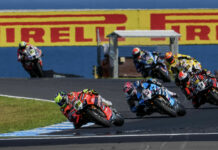HARLEY-DAVIDSON DELIVERS STRONG GROWTH FOR FOURTH QUARTER and FULL YEAR EPS Rises 29.2% in Fourth Quarter, 16.7% for Full Year on Continuing Operations Full-Year New Harley-Davidson Motorcycle Retail Sales Grow 6.2% Worldwide MILWAUKEE, Jan. 29, 2013 A strong fourth-quarter 2012 capped a year of gains for Harley-Davidson, Inc. (NYSE: HOG), marked by solid growth in earnings and retail new motorcycle sales. Fourth-quarter income from continuing operations was $70.6 million on consolidated revenue of $1.17 billion, compared to income from continuing operations in the year-ago period of $54.6 million on consolidated revenue of $1.18 billion. Fourth-quarter 2012 earnings per share were $0.31, up 29.2% compared to EPS of $0.24 in the year-ago quarter. For the full year, Harley-Davidson income from continuing operations was $623.9 million on consolidated revenue of $5.58 billion, compared to full-year 2011 income from continuing operations of $548.1 million on consolidated revenue of $5.31 billion. Full-year 2012 EPS was $2.72, up 16.7% from EPS of $2.33 in 2011. Worldwide retail sales of new Harley-Davidson motorcycles grew 7.5% in the quarter and 6.2% for the full year, compared to the year-ago periods. “Thanks to the outstanding efforts of our employees, dealers and suppliers, Harley-Davidson achieved its growth and restructuring goals in 2012,” said Keith Wandell, Chairman, President and Chief Executive Officer. “The ambitious restructuring of our manufacturing operations, aimed at delivering better responsiveness for customers and greater operating efficiency, is now largely behind us,” Wandell said. “Motorcycle sales grew in 2012, fueled by exceptional products and retail experiences. Together with our dealers, we grew sales to U.S. outreach customers faster than to core customers, grew U.S. market share and continued to expand internationally. “Harley-Davidson’s purpose is to fulfill the dreams of personal freedom for people around the world. Through our strategy, we believe the company is poised to deliver on that purpose like never before,” Wandell said. Retail Harley-Davidson Motorcycle Sales For the full year 2012, retail unit sales of new Harley-Davidson motorcycles grew 6.2% worldwide, with increases of 6.6% in the U.S. and 5.6% internationally compared to 2011. Dealers sold 249,849 new Harley-Davidson motorcycles worldwide in 2012, with retail unit sales up 39.2% in the Latin America region, 14.3% in the Asia Pacific region and 6.2% in the North America region (U.S. and Canada) and down 3.0% in the EMEA region compared to 2011. In the fourth quarter, retail sales of new Harley-Davidson motorcycles increased 7.5% worldwide, compared to the prior-year period, with unit sales up 8.4% in the U.S. and up 6.3% in international markets. Dealers sold 43,405 new Harley-Davidson motorcycles worldwide in the quarter, with retail unit sales up 23.5% in the Latin America region, 14.8% in the Asia Pacific region and 7.3% in the North America region and down 3.3% in the EMEA region compared to last year’s fourth quarter. Industry-wide U.S. heavyweight new motorcycle (651cc-plus) retail unit sales increased 4.0% in 2012 compared to 2011. Fourth-quarter and full-year data are listed in the accompanying tables. Harley-Davidson Motorcycles and Related Products Segment Results Fourth-Quarter Results: Fourth-quarter operating income from motorcycles and related products was $53.1 million, a 49.4% increase compared to operating income of $35.6 million in the year-ago period. Operating income in the quarter benefited from lower restructuring costs and higher gross margin compared to the prior-year period. Revenue from motorcycles during the fourth quarter of 2012 of $771.1 million was down 2.6% compared to the year-ago period. The Company shipped 47,067 motorcycles to dealers and distributors worldwide during the quarter. In the year-ago period, the Company shipped 50,730 motorcycles. Fourth-quarter shipments were in line with guidance and consistent with the Company’s previously announced plans for lower shipments in the quarter related to the implementation of seasonal surge production at York in the first half of 2013. The Company believes surge production will provide the flexibility to produce more motorcycles closer to customer demand during the prime selling season. Revenue from motorcycle parts and accessories totaled $161.6 million during the quarter, up 0.2%, and revenue from general merchandise, which includes MotorClothes® apparel and accessories, was $74.0 million, up 6.8%, compared to the year-ago period. Gross margin was 31.8% in the fourth quarter of 2012, compared to 31.2% in the fourth quarter of 2011. Fourth-quarter operating margin from motorcycles and related products was 5.3%, compared to operating margin of 3.5% in last year’s fourth quarter. Twelve-Month Results: For the full year 2012 the Company shipped 247,625 motorcycles to dealers and distributors, a 6.2% increase compared to 2011. Full-year revenue from motorcycles grew 5.9% to $3.76 billion, revenue from parts and accessories grew 5.3% to $859.9 million and revenue from general merchandise grew 9.2% to $299.4 million, compared to 2011. Gross margin for the full year was 34.8% and operating margin was 14.5%, compared to 33.4% and 12.0% respectively in 2011. Financial Services Segment Results Operating income from financial services was $63.0 million in the fourth quarter of 2012, a 10.9% increase compared to operating income of $56.8 million in last year’s fourth quarter. Full-year 2012 operating income from financial services was $284.7 million, a 5.9% increase compared to operating income of $268.8 million in 2011. Results for the fourth quarter and full year reflect continued improvement in credit loss performance year over year and lower interest expense. Guidance Harley-Davidson expects to ship 259,000 to 264,000 motorcycles to dealers and distributors worldwide in 2013, an approximate 4-1/2% to 6-1/2% increase from 2012. In the first quarter of 2013, the Company expects to ship 71,000 to 76,000 motorcycles, an approximate increase of 10% to 18% from the year-ago period. The Company’s first-quarter shipment plan reflects the implementation of surge production at York in the first half of 2013. The Company expects full-year 2013 gross margin of 35.25% to 36.25 %. The Company expects capital expenditures of $200 million to $220 million in 2013. Restructuring Update In 2012, Harley-Davidson realized savings of $280 million from restructuring activities initiated since early 2009. Restructuring charges were $1.6 million in the fourth quarter of 2012 and $28.5 million for the full year. Upon the completion of restructuring in 2013, Harley-Davidson expects restructuring activities initiated since 2009 to result in one-time overall costs of approximately $495 million, including approximately $13 million in 2013. The Company expects savings of approximately $305 million in 2013 from restructuring activities initiated since 2009, rising to annual ongoing savings of approximately $320 million beginning in 2014. Income Tax Rate For the full year 2012, Harley-Davidson’s effective tax rate was 35.1% compared to 30.9% in 2011. The 2011 effective tax rate benefited from a change in Wisconsin tax law associated with certain net operating losses, the favorable settlement of an IRS audit and the benefit of the federal Research and Development Tax Credit. In 2013, the Company expects its full-year effective tax rate from continuing operations will be approximately 34.8%. Cash Flow Cash and marketable securities totaled $1.20 billion at year-end 2012, compared to $1.68 billion at year-end 2011. In 2012, Harley-Davidson generated $793.1 million of cash provided by operating activities of continuing operations, compared to $885.3 million in 2011. On a discretionary basis, the Company repurchased 1.2 million shares of Harley-Davidson, Inc. common stock during the fourth quarter of 2012 at a cost of $53.4 million. For the full year 2012, Harley-Davidson repurchased 6.5 million shares of its common stock at a cost of $299.6 million. At the end of 2012, there were approximately 226 million shares of Harley-Davidson common stock outstanding and 14.5 million shares remaining on board-approved share repurchase authorizations. In January 2013, Harley-Davidson made a $175 million voluntary contribution to its pension plans. Company Background Harley-Davidson, Inc. is the parent company of Harley-Davidson Motor Company and Harley-Davidson Financial Services. Harley-Davidson Motor Company produces heavyweight custom, cruiser and touring motorcycles and offers a complete line of Harley-Davidson motorcycle parts, accessories, riding gear and apparel, and general merchandise. Harley-Davidson Financial Services provides wholesale and retail financing, insurance, extended service and other protection plans and credit card programs to Harley-Davidson dealers and riders in the U.S., Canada and other select international markets. For more information, visit Harley-Davidson’s Web site at www.harley-davidson.com. Conference Call and Webcast Presentation Harley-Davidson will discuss fourth-quarter results on a Webcast at 8:00 a.m. CT today. The Webcast presentation will be posted prior to the call and can be accessed at http://investor.harley-davidson.com/. Click “Events and Presentations” under “Resources.” The audio portion of today’s call will also be posted at harley-davidson.com beginning approximately two hours after the conclusion of the call for one year. The audio may also be accessed until Feb. 12, 2013 by calling 404-537-3406 or 855-859-2056 in the US, pin number 8342-2435#. Forward-Looking Statements The Company intends that certain matters discussed in this release are “forward-looking statements” intended to qualify for the safe harbor from liability established by the Private Securities Litigation Reform Act of 1995. These forward-looking statements can generally be identified as such because the context of the statement will include words such as the Company “believes,” “anticipates,” “expects,” “plans,” or “estimates” or words of similar meaning. Similarly, statements that describe future plans, objectives, outlooks, targets, guidance or goals are also forward-looking statements. Such forward-looking statements are subject to certain risks and uncertainties that could cause actual results to differ materially from those anticipated as of the date of this release. Certain of such risks and uncertainties are described below. Shareholders, potential investors, and other readers are urged to consider these factors in evaluating the forward-looking statements and cautioned not to place undue reliance on such forward-looking statements. The forward-looking statements included in this release are only made as of the date of this release, and the Company disclaims any obligation to publicly update such forward-looking statements to reflect subsequent events or circumstances. The Company’s ability to meet the targets and expectations noted depends upon, among other factors, the Company’s ability to (i) execute its business strategy, (ii) adjust to fluctuations in foreign currency exchange rates, interest rates and commodity prices, (iii) manage through inconsistent economic conditions, including changing capital, credit and retail markets, (iv) implement and manage enterprise-wide information technology solutions, including solutions at its manufacturing facilities, and secure data contained in those systems, (v) anticipate the level of consumer confidence in the economy, (vi) continue to realize production efficiencies at its production facilities and manage operating costs including materials, labor and overhead, (vii) manage production capacity and production changes, (viii) manage changes and prepare for requirements in legislative and regulatory environments for its products, services and operations, (ix) provide products, services and experiences that are successful in the marketplace, (x) manage risks that arise through expanding international operations and sales, (xi) manage the credit quality, the loan servicing and collection activities, and the recovery rates of HDFS’ loan portfolio, (xii) successfully implement with its labor unions the agreements that it has executed with them that it believes will provide flexibility and cost-effectiveness to accomplish restructuring goals and long-term competitiveness, (xiii) effectively execute the Company’s restructuring plans within expected costs and timing, (xiv) manage supply chain issues, including any unexpected interruptions or price increases caused by raw material shortages or natural disasters,(xv) develop and implement sales and marketing plans that retain existing retail customers and attract new retail customers in an increasingly competitive marketplace, (xvi) adjust to healthcare inflation and reform, pension reform and tax changes, (xvii) retain and attract talented employees, (xviii) manage the risks that our independent dealers may have difficulty obtaining capital and managing through changing economic conditions and consumer demand, (xix) continue to have access to reliable sources of capital funding and adjust to fluctuations in the cost of capital, (xx) continue to develop the capabilities of its distributor and dealer network, and (xxi) detect any issues with our motorcycles or manufacturing processes to avoid delays in new model launches, recall campaigns, increased warranty costs or litigation. In addition, the Company could experience delays or disruptions in its operations as a result of work stoppages, strikes, natural causes, terrorism or other factors. Other factors are described in risk factors that the Company has disclosed in documents previously filed with the Securities and Exchange Commission. The Company’s ability to sell its motorcycles and related products and services and to meet its financial expectations also depends on the ability of the Company’s independent dealers to sell its motorcycles and related products and services to retail customers. The Company depends on the capability and financial capacity of its independent dealers and distributors to develop and implement effective retail sales plans to create demand for the motorcycles and related products and services they purchase from the Company. In addition, the Company’s independent dealers and distributors may experience difficulties in operating their businesses and selling Harley-Davidson motorcycles and related products and services as a result of weather, economic conditions or other factors.
Harley-Davidson’s Worldwide Motorcycle Sales Up 6.2% In 2012
Harley-Davidson’s Worldwide Motorcycle Sales Up 6.2% In 2012
© 2013, Roadracing World Publishing, Inc.






